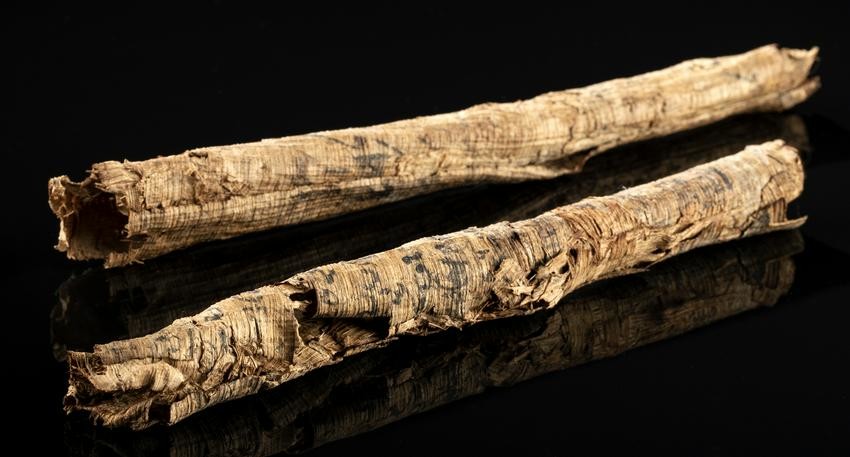Egyptian Ptolemaic Papyrus Scrolls, Demotic Script (2)
Egypt, Ptolemaic Period, ca. 332 to 30 BCE. A beautiful and extremely rare set of two tightly rolled papyrus scrolls. Each lengthy scroll is of a slender form, has open ends that reveal the interior layers, and displays several rows of illegible Demotic script written in black ink. For many centuries, papyrus was the most important writing material in the Classical and Mediterranean world, replacing clay tablets. The reeds used to make papyrus grow primarily in Egypt, and the Graeco-Roman world had to import them on a regular basis. Scrolls like these examples were typically manufactured in rolls up to 100 feet long and 7 to 15 inches wide. These scrolls bear wonderful evidence of the crisscrossing fibers that make up the papyrus. Size of largest: 0.875" W x 7.5" H (2.2 cm x 19 cm).
Demotic script - one of the three languages on the Rosetta Stone - was used specifically for writing documents like literary lessons, religious texts, and administrative ledgers, and represents a development in written language from the more-complex hieroglyphs. After Alexander the Great conquered Egypt in 332 BCE, he introduced the Greek language, which was used as the language of official documents until after 600 CE. Documents like these fragments are often tax rolls or receipts, census records, private records of sales, leases, or loans, marriage contracts, and contracts of apprenticeship. The neat, orderly handwriting on each of these may indicate that it is a religious or biblical literary piece.
A similar group of three scrolls hammered for GBP 8,125 ($9,808) at Bonhams, London, New Bond Street "Antiquities" auction (October 5, 2011, lot 379): https://www.bonhams.com/auctions/18947/lot/379/?category=list&length=526&page=1
Provenance: private Hawaii, USA collection; ex-private Honolulu, Hawaii, USA collection; acquired by Mr. Ezeldeen Taha Eldarir in Egypt in 1929
All items legal to buy/sell under U.S. Statute covering cultural patrimony Code 2600, CHAPTER 14, and are guaranteed to be as described or your money back.
A Certificate of Authenticity will accompany all winning bids.
We ship worldwide to most countries and handle all shipping in-house for your convenience.
#148295
Condition Report: Both scrolls have losses to ends and desiccation commensurate with age and fragility, fading to original black ink, light staining, and chipping to some exterior layers. Great traces of original black ink throughout.
View it on
Estimate
Time, Location
Auction House
Egypt, Ptolemaic Period, ca. 332 to 30 BCE. A beautiful and extremely rare set of two tightly rolled papyrus scrolls. Each lengthy scroll is of a slender form, has open ends that reveal the interior layers, and displays several rows of illegible Demotic script written in black ink. For many centuries, papyrus was the most important writing material in the Classical and Mediterranean world, replacing clay tablets. The reeds used to make papyrus grow primarily in Egypt, and the Graeco-Roman world had to import them on a regular basis. Scrolls like these examples were typically manufactured in rolls up to 100 feet long and 7 to 15 inches wide. These scrolls bear wonderful evidence of the crisscrossing fibers that make up the papyrus. Size of largest: 0.875" W x 7.5" H (2.2 cm x 19 cm).
Demotic script - one of the three languages on the Rosetta Stone - was used specifically for writing documents like literary lessons, religious texts, and administrative ledgers, and represents a development in written language from the more-complex hieroglyphs. After Alexander the Great conquered Egypt in 332 BCE, he introduced the Greek language, which was used as the language of official documents until after 600 CE. Documents like these fragments are often tax rolls or receipts, census records, private records of sales, leases, or loans, marriage contracts, and contracts of apprenticeship. The neat, orderly handwriting on each of these may indicate that it is a religious or biblical literary piece.
A similar group of three scrolls hammered for GBP 8,125 ($9,808) at Bonhams, London, New Bond Street "Antiquities" auction (October 5, 2011, lot 379): https://www.bonhams.com/auctions/18947/lot/379/?category=list&length=526&page=1
Provenance: private Hawaii, USA collection; ex-private Honolulu, Hawaii, USA collection; acquired by Mr. Ezeldeen Taha Eldarir in Egypt in 1929
All items legal to buy/sell under U.S. Statute covering cultural patrimony Code 2600, CHAPTER 14, and are guaranteed to be as described or your money back.
A Certificate of Authenticity will accompany all winning bids.
We ship worldwide to most countries and handle all shipping in-house for your convenience.
#148295
Condition Report: Both scrolls have losses to ends and desiccation commensurate with age and fragility, fading to original black ink, light staining, and chipping to some exterior layers. Great traces of original black ink throughout.



